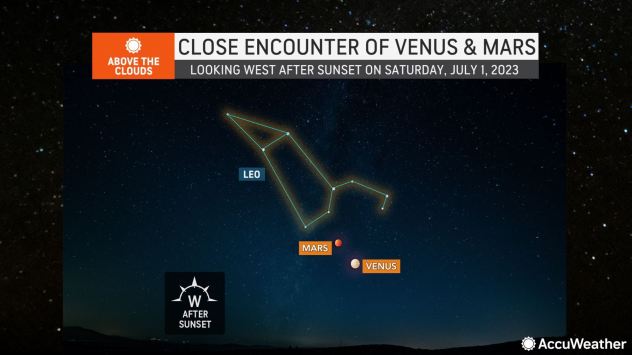
July will kick off with a pairing of planets, the opening act of a month packed with astronomy events including a supermoon and dueling meteor showers.
On Saturday evening, Venus and Mars will glow side-by-side in an astronomical event known as a conjunction. This will be the closest the two planets have appeared in the night sky since March 2022 – and they will not appear this close again until next February.
It will be easy to spot the duo in the western sky below Leo, a constellation named after the legendary Nemean Lion from Greek mythology. According to ancient mythology, the hero Hercules battled the monstrous lion a the start of his 12 labors.

Venus will be the keystone of the event, serving as a reference point for stargazers who have difficulty spotting Mars, which will appear significantly dimmer than its celestial counterpart.
While Venus will be bright enough to spot early in the evening, Mars may not be visible until about an hour after sunset, faintly glowing above and to the left of Venus. It will appear orange, helping the red planet stand apart from most of stars that appear white.
The best viewing conditions for this weekend’s astronomical convergence will be across the western half of the United States and the Canadian Prairies, where largely cloud-free conditions are expected. Fair to good sky conditions are also predicted over most of the Gulf Coast.
Meanwhile, a far-reaching storm system will usher clouds, showers and thunderstorms over most of the Midwest and Northeast, as well as the most populated areas in the Canadian provinces of Ontario and Quebec. A large pocket of clouds may also block out views of Mars and Venus over parts of Texas, Oklahoma, Arkansas and Missouri.
If cloudy conditions obscure the sky Saturday, stargazers can look for the pairing of planets Sunday evening, although the two objects will appear slightly farther apart.
Mars and Venus will slowly separate in the evening sky as July progresses, appearing farther apart each night.
By the end of the month, Venus will no longer be visible to evening stargazers since it will dip below the horizon around the same time as the sun. Meanwhile, Mars will continue to glow faintly above the western horizon each evening into August.
Produced in association with AccuWeather







